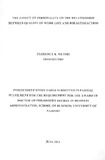| dc.description.abstract | The workforce has undergone a transformation leading to an increase in dual-career families. These dual-carSer couples face many stressors in balancing career, family, social obligations and work expectations. Changing societal trends such as an increase in the number of women entering the work force combined with an economy that requires dual incomes to support an average standard of living contribute to work-family conflicts. As a result, society and businesses have recognized the conflicts unique to dual-career families and have responded by and many organizations have begun to take a role in developing quality of work-life programs.
Quality of work life has been defined as the employee perceptions of their physical and mental well being at work. These perceptions can be favourable or unfavourable. Quality of work life encompasses working conditions, working time, mode of wages payment, health hazards issue, in a nutshell some of financial and non-financial benefits and management behavior towards workers QWL is also the feelings that employees have towards their jobs, colleagues and the organization.
Studies have established a link between certain quality of work life practices and job satisfaction. It has been established that job satisfaction exhibit strong associations in expected directions with measures of a large number of w'ork attributes, which include diverse aspects of work contents (as variety, task significance and skill use), pay and other benefits, job security, promotion opportunities, recognition, work conditions, relations with coworkers and supervisors, effective communication structures in the firms, and participation in managerial decision making. Reward, job security, health and safety of the workplace and other tangible benefits due to work have been identified as extrinsic determinants of QWL where as the task content, autonomy, social relations at work and other intangible benefits have been identified as the intrinsic determinants of QWL. Significant associations have been established among variables of work environment, and job satisfaction and life satisfaction.......................................................................... | en_US |

